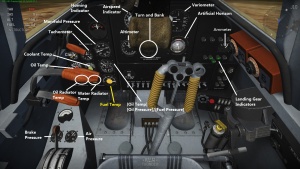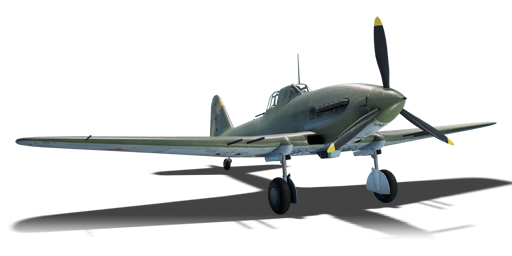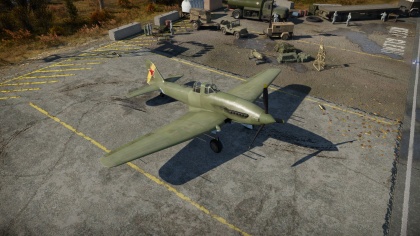IL-10 (1946)
Contents
Description
The IL-10 (1946) is a Rank IV Soviet attacker aircraft with a battle rating of 5.0 (AB) and 5.3 (RB/SB). It was introduced in Update 1.41.
As a continuation of the famed Ilyushin IL-2 series, the IL-10 (1946) is a highly upgraded version of the classic Soviet ground attacker of World War Two. Unlike its predecessors, who wield a pair VYa 23 mm cannons, the IL-10 (1946) utilizes four NS-23 23 mm cannons which increase the plane's anti-aircraft capabilities, at the expense of anti-armour stopping power (31 mm -> 21 mm). The IL-10 (1946) is also highly capable of defending itself from the rear, unlike its earlier relatives which wielded a single 12.7 mm Berezin UB machine gun. This aircraft boasts a 20 mm Berezin B-20 cannon capable of ripping would-be killers apart. Although extremely dangerous in a low-speed and low-altitude dogfight, this aircraft suffers at both higher altitudes and higher speeds, where post-war fighters such as the F8F-1B have the advantage. The IL-10 (1946) also features an armored cockpit and engine, which increases the aircraft's resistance to sub-caliber armor piercing rounds. Thus, just like its earlier relatives, the IL-10 is a very heavy aircraft which can hurt performance aspects such as acceleration.
The IL-10 (1946) wields an impressive armament of four 23 mm NS-23 cannons, placed in the wings. While not capable of destroying heavy ground targets, these cannons are extremely deadly to single, twin, and quad-engine aircraft alike. The rounds have a fairly slow muzzle velocity, however, so it is crucial to lead the target properly, especially in a dogfight. Equipping the "air targets" belt is the best choice as it serves the both light-ground attack and anti-aircraft roles very well.

General info
Flight Performance
| Characteristics | |||||||
|---|---|---|---|---|---|---|---|
| Stock | |||||||
| Max Speed (km/h at 2,650 m) |
Max altitude (meters) |
Turn time (seconds) |
Rate of climb (meters/second) |
Take-off run (meters) | |||
| AB | RB | AB | RB | AB | RB | ||
| 503 | 487 | 7,600 | 28.5 | 26.6 | 6.2 | 7.6 | 550 |
| Upgraded | |||||||
| Max Speed (km/h at 2,650 m) |
Max altitude (meters) | Turn time (seconds) | Rate of climb (meters/second) |
Take-off run (meters) | |||
| AB | RB | AB | RB | AB | RB | ||
| ? | ? | 7,600 | ??.? | ??.? | ?.? | ?.? | 550 |
Details
| Features | ||||
|---|---|---|---|---|
| Combat flap | Take-off flap | Landing flap | Air brakes | Arrestor gear |
| ✓ | ✓ | ✓ | X | X |
| Limits | ||||
|---|---|---|---|---|
| Wing-break speed (km/h) |
Gear limit (km/h) |
Combat flap (km/h) |
Max Static G | |
| + | - | |||
| 720 | 450 | ??? | ~13 | ~13 |
| Optimal velocities | |||
|---|---|---|---|
| Ailerons (km/h) |
Rudder (km/h) |
Elevators (km/h) |
Radiator (km/h) |
| < 370 | < 410 | < 400 | > 260 |
| Compressor (RB/SB) | ||
|---|---|---|
| Setting 1 | ||
| Optimal altitude | 100% Engine power | WEP Engine power |
| 1,500 m | 1,770 hp | 2,009 hp |
Survivability and armour
- No armour plating
- No armour glazing
- Critical components located at front of aircraft (fuel, pilot, engine, controls)
- More fuel tanks located in wings near fuselage
Armaments
Offensive armament
The IL-10 (1946) is armed with:
- 4 × 23 mm NS-23 cannons, wing-mounted (150 rpg = 600 total)
Suspended armament
The IL-10 (1946) can be outfitted with:
- 2 x 50 kg FAB-50 bombs
- 2 x 100 kg FAB-100 bombs
- 2 x 250 kg FAB-250M43 bombs
- 4 x RS-82 rockets + 2 x 50 kg FAB-50 bombs
- 4 x RBS-82 rockets + 2 x 50 kg FAB-50 bombs
- 4 x RS-132 rockets + 2 x 50 kg FAB-50 bombs
- 4 x RBS-132 rockets + 2 x 50 kg FAB-50 bombs
- 4 x RS-82 rockets + 2 x 100 kg FAB-100 bombs
- 4 x RBS-82 rockets + 2 x 100 kg FAB-100 bombs
- 4 x RS-132 rockets + 2 x 100 kg FAB-100 bombs
- 4 x RBS-132 rockets + 2 x 100 kg FAB-100 bombs
Defensive armament
The IL-10 (1946) is defended by:
- 1 × 20 mm B-20E cannon, dorsal turret (300 rpg)
Usage in the battles
NS-23 cannons are not capable of destroying medium or light tanks even with AP ammunition. This severely hinders the aircraft's ground attack capabilities, so it is best utilized as a multi-purpose aircraft similar to the B7A2 Ryusei. However, it is worth nothing that this aircraft wields the ability to carry a varied payload of both bombs and rockets. With proper aim, it is possible to destroy heavy tanks albeit very difficult as there is no bombing reticule. The "air targets" belt for the 23 mm cannons have the ability to demolish soft ground targets such as armored cars and AAA units, but also retains the ability to destroy fighters and bombers alike with only a handful of rounds. Therefore, it can be beneficial to first attack the enemy's light defenses and then if a teammate has been forced to a lower altitude by a pursuer, attempting to alleviate the stress of that pilot can be beneficial. Like the La-9, the IL-10 (1946) has the ability to fire two of its 23 mm cannons instead of four as the ammunition pools are separate. A good strategy is to use one set of 23 mm belts for attacking ground targets, and the other for destroying enemy aircraft.
If found in a sticky situation, the IL-10 (1946) pilot may choose to call for help or to "roll the dice" and use the 20 mm tail cannon. While it is effective, hitting the enemy at longer distances can be very difficult, especially without the "new 20 mm cannon (turret)" module upgrade. It is best to lure an enemy by turning and evading their fire, and then lining them up directly with your tail cannon. It is possible to destroy the enemy aircraft with less than 10 shells if they are very close and the tail gunner is accurate. Another unorthodox method of using the 20 mm tail cannon involves a situation in which an initial pass on a ground target failed. Depending on how close the IL-10 (1946) is to the ground target, it is possible to destroy it from behind with the 20 mm tail gun. This is very difficult especially as the distance from the target increases.
Manual Engine Control
| MEC elements | ||||||
|---|---|---|---|---|---|---|
| Mixer | Pitch | Radiator | Supercharger | Turbocharger | ||
| Oil | Water | Type | ||||
| Controllable | Not controllable | Not controllable | Not controllable | Separate | Not ontrollable | Not controllable |
Modules
| Tier | Flight performance | Survivability | Weaponry | ||
|---|---|---|---|---|---|
| I | |||||
| II | |||||
| III | |||||
| IV | |||||
Since the IL-10 (1946) is a multi-role aircraft any module research path is viable. Unlocking performance modules will boost survivability and damage potential in dogfights, whereas unlocking armament modules will help with ground attack. Some of the best modules to unlock are the "engine injection" and "offensive 23 mm belts". Any of the turret upgrades will also improve potential damage output.
Pros and cons
Pros:
- Forward-firing 4 x 23 mm cannons can do massive damage
- Defensive 20 mm gunner with 300 rounds of ammunition for protection (won't always save you, but can bring down stupid enemy fighters reliably)
- Accelerates rather quickly (useful for gaining distance from a failed ground strike)
- Versatile payload of bombs and rockets
- Highly armored cockpit
- Durable aircraft, can absorb damage
- Good maneuverability for an attacker
Cons
- Large aircraft, easy target
- 23 mm are difficult to aim due to low muzzle velocity
- Lots of armor plating in cockpit, hinders visibility (if playing SB)
- Cannot perform high-speed manoeuvres
- Bleeds energy extremely quickly
- Very slow roll rate
- Low top speed, manuverabillity and climb rate
- NS-23 still does not have the penetration to damage medium tanks, even with API-T at optimal angles.
- Almost no protection for rear gunner
History
Describe the history of the creation and combat usage of the aircraft in more detail than in the introduction. If the historical reference turns out to be too big, take it to a separate article, taking a link to an article about the vehicle and adding a block "/ historical reference" (example: https://wiki.warthunder.com/Name-vehicles/historical reference) and add a link to it here using the main template. Be sure to include links to sources at the end of the article.
Media
An excellent addition to the article will be video guides, as well as screenshots from the game and photos.
Read also
Links to the articles on the War Thunder Wiki that you think will be useful for the reader, for example,
- reference to the series of the aircraft;
- links to approximate analogues of other nations and research trees.
Sources
Paste links to sources and external resources, such as:
- topic on the official game forum;
- page on aircraft encyclopedia;
- other literature.
| USSR strike aircraft | |
|---|---|
| IL-2 | IL-2 (1941) · IL-2 (1942) · IL-2M (1943) · IL-2M type 3 · IL-2M "Avenger" · IL-2-37 · IL-2 M-82 |
| IL-8 | IL-8 (1944) |
| IL-10 | IL-10 · IL-10 (1946) |
| Pe-3 | Pe-3 (e) · Pe-3 · Pe-3bis |
| Su-2 | BB-1 · Su-2 MV-5 · Su-2 TSS-1 · Su-2 (M-82) |
| Su-6 | Su-6 · Su-6 (AM-42) · Su-6 (M-71F) |
| Su-8 | Su-8 |
| Tandem MAI | Tandem MAI |
| TIS MA | TIS MA |
| Tu-1 | Tu-1 |
| Yak-2 | Yak-2 KABB |





